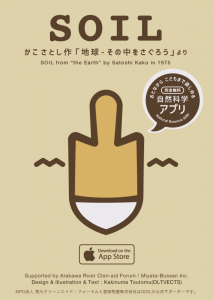[Question] Do you eat plastics every day, without fail?
Right answer is… 「YES !」
What? You may feel that way. Have you heard of micro-plastics?
☑ What is micro-plsastic?
☑ 「Micro-plastic」 VS. 「NPO Arakawa River Clean-aid Forum」
Q: “What is「micro-plastics」 (referred to as “MPs” hereafter)?” A:“It is a collective term for plastics 「with 5 millimeter or less in diameter size」.”
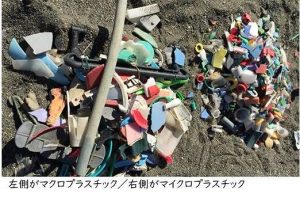
Plastics exist abundantly around us.
Plastic as material has useful features such as lightness, durability and easiness to craft, beyond some other materials such as paper, wood or metal. It can be said that it is a material which is indispensable for our life. However, while it is a good material, plastic inevitably deteriorates as time passes. Further, it becomes fragmented in smaller pieces. Regardless of the original size of any plastic products, eventually they become small MPs (unless they are incinerated). For instance, plastic-made clothespins become fragile over time and crack producing small fractions and/or powdery substance. They are MPs.
Besides, plastic fractions lager than 5 millimeter in diameter are called “macro-plastics”.
POINT:Plastics become MPs by deterioration.
Q:“Where are MPs located?” A: “Wherever, all over the world – in soil, in the atmosphere, in deep sea, and even within human bodies…”

Plastic is a 「sturdy」material.
While pieces of plastics would become smaller over time, plastic does not stop being plastic however small it becomes. Larger plastics (macro-plastics) just turn into smaller plastics (MPs). For plastics to be truly decomposed by microorganism, like paper or wood, it takes an enormous amount of time. Eventually, they become so small that cannot be seen with human eyes.
MPs are small and light would move to anywhere on the earth by winds and water. Now, they exist from the top of the Mt. Everest to depth of the Mariana Trench and also within the bodies of creatures (including those of humans). Since amount of plastic products production continues to increase (see the diagram below), impact of MPs on natural environment ever increases.
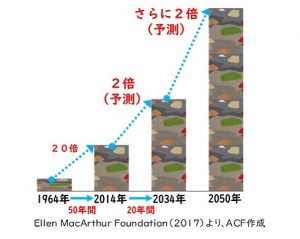
POINT:Plastics stay to be plastics however small they become.
Q:How does MP affect creatures and humans? A:Plastic, which is a “foreign substance” to the natural world, can break the balance of the natural world.
Until humans created plastic, there was (almost) no plastic in nature. (*)
Therefore, we do not have a mechanism for returning human-made plastics to nature again, and decomposing it requires a very long time(called “hard decomposition”). At least, it will not returned nature in the “100 years” that is said to be the average life expectancy of the Japanese in the future (Nakajima, 2019).
The natural world is made up of food chains, but its balance is very delicate and fragile. Plastics, which continue to exist in large quantities in nature, are “foreign substances” and continue to accumulate. Nowadays, the “foreign substance” called plastic is trying to break the balance in nature.
(*) There are substances that can be called plastics in the natural world, such as amber and beeswax made by bees.
① Impact to Creature
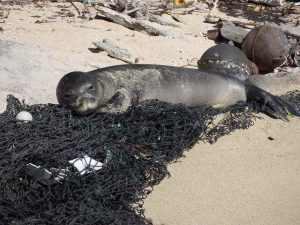
Various creatures of all sizes accidentally ingest plastic.
Seabirds tangled with fishing lines and sea turtles and whales that mistakenly eat plastic for food are talked about in the news, but it is said that 90% of seabirds, and more than 200 species of marine life mistakenly eat plastic trash (Takada et al., 2019).
We humans do not often mistake plastic for food. Even small pieces of plastic are rejected due to sense of discomfort if they get in your mouth. But several of the creatures cannot do make this distinction.
POINT:Many creatures mistakenly eat plastic for food.
(Reference) 『For hungry sea turtles, undersea plastic bags smell like food』(CNN,2020/03/11)
② Impact to Humans
MPs have also been detected in many foods and drinks that we eat.
Humans also eat plastics from seafood. We cannot notice a small MP that you can’t see.
It is said that, even if MP is ingested, it will not be absorbed by the human body but it will be excreted, so currently, it is said that there is no major health impact. However, due to the nature of plastics to adsorb chemical pollutants in water, humans may have ingested pollutants including MP. There are still many unclear points about the health effects of ingesting MP, and research is ongoing (Gendatsu, 2020).
You wouldn’t want to eat food with plastic in it, even if you are told, “There is no health risk (for now).”
POINT:Humans also eat MP (impact on health is unclear)
(Reference) 『Ingestion of plastic into the body, research results for one credit card per week』(AFPBB News,2019/06/12)
So far, we have been introducing “MP”…
How is「 “Arakawa River Clean-aid Forum” 」「“ACF”」)facing the MP problem?
Q:What is 「Arakawa River Clean-aid」? A:It is an activity to collect Arakawa River’s trash before it flows into the sea!
As the name implies, the main activity of ACF is “Arakawa River Clean-aid”. Roughly speaking, it is “cleaning the riverbank”.
About 10 million people live in the basin of Arakawa River, which flows through Saitama Prefecture and Tokyo.
It is said that most of the trash that flows into the sea comes from the activities of people on land. Only a small percent of the 10 million people may inadvertently or deliberately throw away the trash that pass through waterways in each region and Arakawa river and finally flowing into Tokyo Bay (Pacific Ocean).
*Of course there are some source of trash.

The ocean is tremendously large and wide. Once a small piece of trash has flowed into the ocean, it is almost impossible to collect it.。ACF uses a river clean aid method to collect trash before it enters the sea.
POINT:“Arakawa River Clean-aid” collects trash before it flows into the ocean.
Q:What effect does River Clean-aid have on MP problems? A:① You can collect plastic trash before it becomes MPs ② The changes in the participants will turn into great power
① Collect plastic trash before it becomes MP
As Clean-aid participants pick up trash such as plastic bottles and notice the presence of colorful MPs mixed with sand and pebbles. And realize the difficulty of collecting MPs.The MP is very small, and there are many that crumble due to deterioration.

If you leave the plastic trash as is, it will definitely be MP. And, it will eventually be reduced to a level that is invisible to humans. Once this happens, you can no longer retrieve them. The only option is to collect them at the stage where people can pick it up.
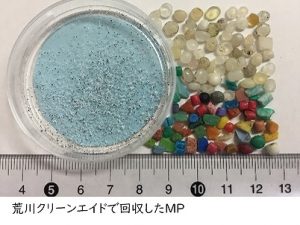
No matter how many times a large-scale Clean-aids are carried out through dozens if not hundreds of people, before we know it, a large amount of trash will accumulate on the banks of the Arakawa River. But, if we can collect the trash there, we can reduce the amount of MP following into the ocean from the rivers. However, the trash washed up on the riverbank is only the tip of the iceberg. Much more is flowing into the Pacific than is recovered by ACF cleanup activities. Unfortunately, clean-aid alone cannot solve the MP problem…
POINT:It is a battle to collect plastic trash before it becomes MP
② The changes within participants into great power
It is estimated that in 2010, about 4.8 to 12.7 million tons of plastic trash was released to the ocean (Jambeck et al., 2015). If plastic production and ocean spills continue at this pace, it is reported that by 2050, the weight of plastics in the ocean will exceed the total weight of fish (Ellen MacArthur Foundation, 2016).
Seeing is believing
Clean-aid participants are stunned by the large amount of debris in front of them. While also having feelings of fun, participants have intense feelings while collecting trash. Through grappling with MP that cannot be picked up because it quickly deteriorates, participants experience the seriousness of ocean pollution caused by plastic.
It is true that MP problems cannot be solved by the Arakawa River Clean-aid alone. However, if the awareness of everyone involved in Clean-aid to the MP problem changes, it will spread to their daily life and work. This change is the greatest effect to the Clean-aid MP problem.
POINT: Changing the hearts and minds of the participants is the best power we have against MP.

QWhat is the target of ACF? A:① To let as many people as possible know about the micro-plastic problem through Clean-aid ② To expand Arakawa’s activity model all over Japan and all over the world.
As mentioned above, in order to solve the micro-plastic problem, let as many people as possible know the current state and seriousness of the problem, and as many as one of them take action in their daily lives and workplaces. Will be a great power.
The method of Clean-aid, which allows you to see and understand the seriousness of micro-plastic problems, has the impact of making participants feel that micro-plastic problems are their own problems.)We would like more people to participate in Clean-aid mainly on Arakawa River, and we would like to increase the number of friends aiming to solve micro-plastic problems. (Annual; about 190 location, about 11,700 people in total)
☆Message of the ACF staff
Arakawa River Clean-aid cannot solve the micro-plastic problem.
The sea is connected to the world. In order for river clean-aid to be effective in solving micro-plastic problems on a global scale, clean-aid must be carried out in rivers around the world.
ACF aims to expand this model all over Japan and all over the world, using activities on Arakawa River as a model. And we will collaborate with colleagues around the world who aim to solve micro-plastic problems.
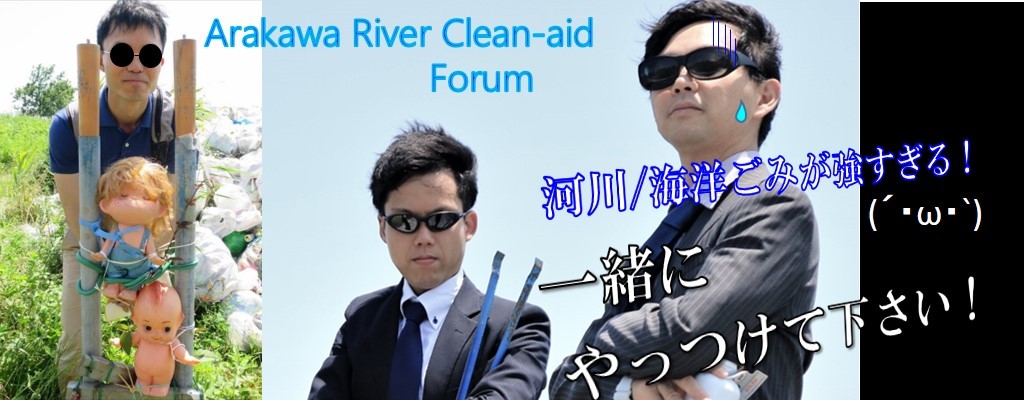
ACF is not needed if there is no trash from the river after thorough reduction of plastic trash (prevention) and cleaning of the river (treatment). The final goal is “dissolution of organization.”
It seems that it will still take some time to dissolve if you see a large amount of trash that is increasing…
Responsibility: TERAMACHI (ACF Division)
[Reference/Citation source] 『プラスチックの現実と未来へのアイデア』東京書籍,高田秀重監修,2019 『海洋プラスチック汚染』岩波書店,中嶋亮太著,2019 『脱プラスチックへの挑戦 持続可能な地球と世界ビジネスの潮流』山と渓谷社,堅達京子ら,2020 [参考文献] Jambeckら,「plastic trash inputs from land into the ocean」science (2015) Ellen MacArthur Foundation「The New Plastics Economy: Rethinking the future of plastics」(2016)
The Mitsui & Co. Environment Fund(1st: Oct. 2016 ~Sep.2019 )(2nd : April 2020 ~Mar. 2022)
The Project for Studying Marine Litter Reduction Measures in Urban River Arakawa
[Background and Issue Summary]
There are concerns that artificial litter (mainly plastics) could cause multifaceted problems in ecosystems, food issues, water, and sustainable consumption and production. It is said that 90% of marine litter is discharged from 10 rivers in developing countries, mainly in Asia, and we need to solve this problem as soon as possible before it causes more serious damage.
On the other hand, the amount of river litter per unit population is based on data from Europe and the United States, and domestic data is considered to be necessary.
This project will examine the amount of river litter and its control, targeting the Arakawa River, which has one of the largest populations in Japan.
*Some of the activities in this project are not open to the public.
[Purpose of this project]
According to Jambeck et al.’s article(2015), the amount of marine litter generated in Japan is estimated at 20,000-60,000 tons and is becoming more prevalent.
Japan’s annual plastic production is 9 million tons, of which 2-7% is a figure that many in Japan question the estimation method.
It is necessary to determine and verify the amount of litter per unit population in the Arakawa River, which has one of the largest populations of rivers in Japan.
▼Result
Now on going…
Stopping plastic-waste before discharged into the sea!-Measures against plastic waste from Arakawa!-
【Background and assembling agendas】
The amount of plastic waste that discharged into the sea is estimated to be 8 million tons (intermediate value) (Science, 2015). In recent years, marine plastic waste has been highlighted as one of the global issues and it is written in the Summit leaders’ Declaration to prevent and reduce plastic waste discharged into the sea. Ultraviolet light and friction break down plastic waste into smaller pieces in nature. Plastic waste smaller than 5 millimeters are collectively called “microplastics” and the total surface area is massive. Hazardous chemical substances such as polychlorinated biphenyl (PCBs) are found on the surface of microplastics and ingested into creatures’ bodies by accident. According to a research by Professor Takada from Tokyo University of Agriculture and Technology, microplastics was detected in 80% of anchovies caught in Tokyo Bay and it pointed out the possibility of future health risks not only to the ecosystem but also those who eat them. The effects of microplastics in the ecosystem are not researched enough and if an effect occurs very slowly, the consequence will remain unknown. These problems have been gradually revealed in recent years, but concrete solutions that can be done at the level of civic action have not been found yet. We, Arakawa River Clean-aid Forum, have been researching and collecting waste in Arakawa River for over 25 years since 1994. Research for over 20 years revealed that most of the waste is plastic such as containers and packaging waste. Even though we collect waste from the river every year, a lot of waste is continuously generated and disposed of everywhere in the city. Even under such situation, we think it is a high-priority goal to collect the rapidly increasing plastic waste as soon as possible and efficiently. We collect artificial waste in nature as soon as possible and prevent it from becoming microplastics.
【Purpose of our activity】
To establish an efficient collecting method and timing by monitoring and researching the relationships between plastic waste that remains in the river and the tide level and analyzing the mechanism of how long it takes until the retention of plastic waste after once cleaning up the area. Also, to share information with citizens on the issues of plastic waste by cooperating with industry groups such as the “Japan Plastics Industry Federation” which research the amount of artificial plastic waste discharged per small watershed.
【Goals during the grant period】
- ・To Establish a method of collecting plastic waste efficiently.
- ・To reduce and control plastic waste discharged from Arakawa River into the ocean
【Long term goals】
- ・To disseminate the results of the research and analysis carried out through this activity, and have them used to solve the plastic waste problems faced by other rivers.
- ・To Share the results with administrative agencies as basic data for river management.
▼Summary of the results
Representative results are as below. Details can be found in our report collection.
River mouth
The last stronghold where you can collect river waste generated by 10 million people living in the Arakawa River basin.
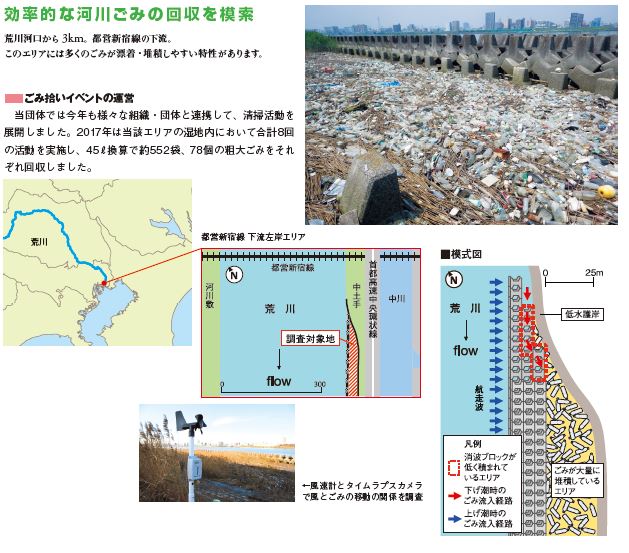
- The amount of river waste flowing into the area is one to two orders of magnitude greater than the outflow.
- A huge amount of river waste flows in from the up stream when the tide changes from flood to ebb.
- For details, see the paper by Kataoka et al. (2017).
Downstream
Accidentally, artificial structures happen to make an environment where river waste can easily accumulate.
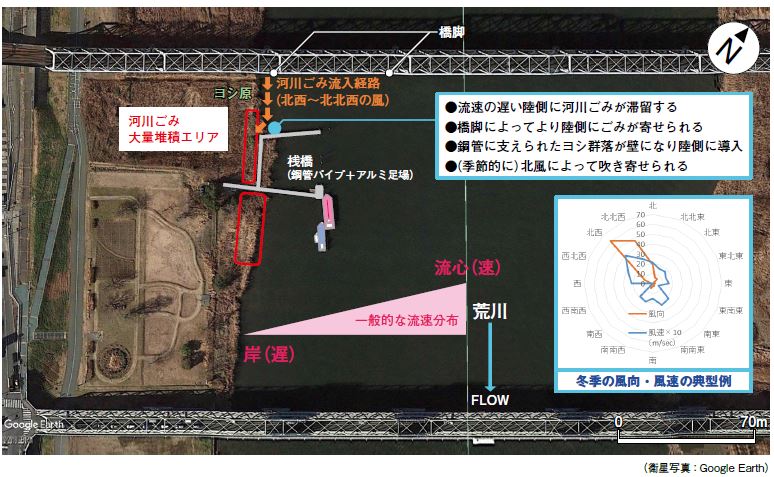
- River waste will stay near the landward side of the river where the stream is slow, thus it will be drawn to the landward side by the flow field near the bridge column.
- The reed colonies supported by steel pipes of the scaffolding create an approach channel and river trash is drawn by the north wind.
Drainage pump station
We research the amount of river waste trapped at a drainage pump station connected to the mainstream in its tributary which we know how many people live in its basin. The research is carried out in cooperation with the government, and the results will be used to estimate the amount of river waste discharged by per unit of population.
◆Basic research of the target small river
・Length of river channel: 5.5km
・Population density of the city: 9,376 inhabitants/km2
・Basin area: 18.5km2
・Operational status of the drainage pump: 1t/sec and 2 pumps are inconstant operation
・Amount of river waste per day: 60kg (2016:including nature waste)
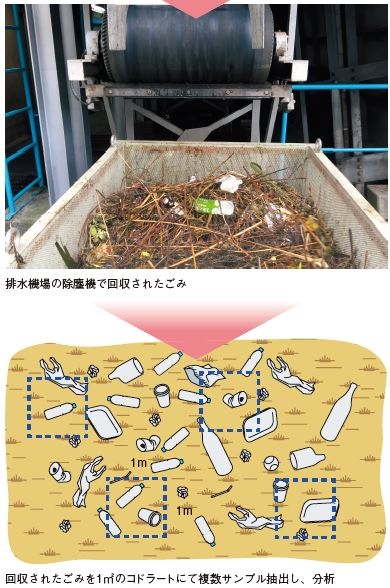
- The composition ratio of river waste: ●● (according to the periodic survey)
- The amount of river waste per population in the river basin: ●● (according to the periodic survey)
This project was conducted with the support of the Mitsui & Co. Environmental Fund (2016-2019).
The person in charge: IMAMURA Kazuyuki.
■Approach to source control: In light of the law of diminishing marginal utility*, it is not realistic to completely eliminate waste discharged into rivers/the ocean. Even with strict management, there will always be a certain amount of waste that will be released into the natural world on a probabilistic basis (population ratio). This project focuses on how to efficient collect waste that has already been released into environment. Of course, in terms of source control, reducing single-use plastics that are not really necessary, such as excessive packing is more important.
*The effect you will get by inputting goods (product and service) per unit volume will gradually decrease.
Reference
The Nippon Foundation and Coca-Cola(Japan)Company have conducted a
iOS application SOIL / by Dr. KAKO Satoshi ~the Earth~
“Soil” is a remake application of the scene (terrain) in KAKO Satoshi’s masterpiece “Chikyuu sono naka wo sagurou” (The Earth, Let’s explore it), published in 1975, drawn by KAKINUMA Tsutomu with the theme of “soil”.
In addition to this work, we created “Arakawa River Estuary 1 (Micro) and Arakawa River Estuary 2 (Macro)” as EXTRA STAGE to think about “river litter problem”.
